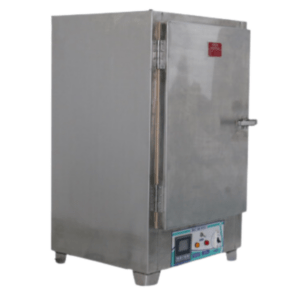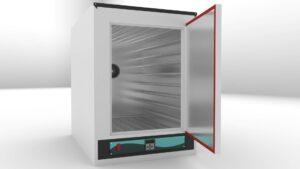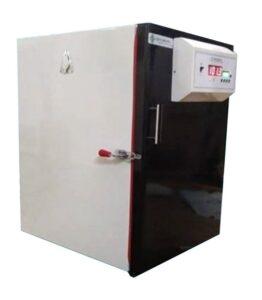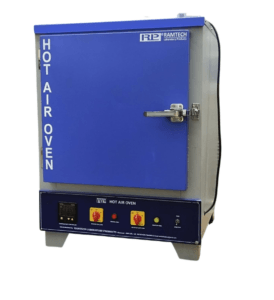Are you in the medical industry and looking for a reliable solution to meet your heating and sterilization needs? Look no further than the versatile and efficient hot air oven. In this blog, we will explore the different types of hot air ovens and their uses in various medical applications. We’ll also delve into the features of digital hot air ovens, the importance of safety with explosion-proof models, and best practices for cleaning and maintenance.
Understanding the Different Types of Hot Air Ovens
Medical hot air ovens, also known as medical drying ovens or medical sterilization ovens, are used in various healthcare and laboratory settings to sterilize equipment, materials, and instruments through the application of dry heat. These ovens play a critical role in maintaining sterile conditions and preventing the spread of infections. While there might not be a wide variety of distinct “types” of medical hot air ovens, they can be categorized based on certain features and specifications. Here are some common distinctions.
- Standard Gravity Convection Ovens: These ovens rely on natural convection currents to circulate hot air throughout the chamber. They are suitable for general sterilization purposes and are often used in laboratories and healthcare facilities.
- Forced Air Convection Ovens: These ovens have a fan or blower that actively circulates hot air within the chamber, ensuring more uniform temperature distribution. They can be more efficient and faster in reaching the desired temperature and are suitable for applications where precise and consistent heating is required.
- High-Temperature Ovens: These ovens are designed to reach higher temperatures than standard ovens. They are often used for specific sterilization processes that require elevated temperatures.
- Vacuum Ovens: Vacuum ovens combine dry heat sterilization with reduced pressure. They are used for materials that are sensitive to oxidation or when it’s essential to remove volatile substances during the sterilization process.
- Infrared Ovens: Infrared ovens use infrared radiation to generate heat. They can offer rapid and efficient heating, which is useful for certain sterilization applications.
- Portable or Benchtop Ovens: These compact ovens are designed to fit on laboratory benches or small workspaces. They are suitable for smaller-scale sterilization tasks.
- Large Capacity Ovens: These ovens are designed for bulk sterilization of larger equipment or quantities of materials. They have a higher internal volume and can accommodate larger loads.
- Digital and Programmable Ovens: These ovens feature digital controls and programmable settings, allowing users to set precise temperature and time parameters for sterilization cycles.
- Multipurpose Ovens: Some ovens are designed to serve multiple functions beyond sterilization, such as drying, curing, or heat-treating various materials.
- Incubator Ovens: While not strictly for sterilization, these ovens provide a controlled environment with temperature and humidity regulation, suitable for incubating cultures or performing experiments that require controlled conditions.
It’s important to note that the classification of medical hot air ovens can vary based on manufacturers, models, and specific applications. When selecting an oven for your medical or laboratory needs, consider factors such as temperature range, capacity, uniformity, safety features, and any specialized requirements of the materials being sterilized.
Exploring the Uses of Laboratory Hot Air Ovens
Laboratory hot air ovens play a crucial role in the medical field, offering a wide range of uses and applications. Here are some common applications of laboratory hot-air ovens.
- Sterilization: Hot air ovens are used to sterilize laboratory equipment, glassware, and instruments by subjecting them to high temperatures, effectively eliminating bacteria, fungi, and other microorganisms.
- Sample Drying: These ovens are employed to remove moisture from samples or materials, facilitating further analysis, testing, or experimentation.
- Heat Treatment: Laboratory hot air ovens are used for heat treatment processes, such as annealing, curing, and aging, to alter the properties of materials or induce specific reactions.
- Research and Development: Hot air ovens are utilized in research and development laboratories to study the effects of temperature on various substances, conduct thermal stability studies, and investigate material behavior under controlled heating conditions.
- Quality Control: These ovens are essential for quality control processes, ensuring the consistency and reliability of products by subjecting them to specified temperature conditions.
Laboratory hot air ovens provide precise and controlled heating, making them indispensable tools in scientific research, analysis, and testing within the medical industry.
Unveiling the Technology Behind Forced Convection Hot Air Ovens
Forced convection hot air ovens employ advanced technology to achieve efficient and uniform heat distribution within the chamber. The key technology behind these ovens is the use of a fan or blower system. This system circulates the heated air throughout the oven, promoting better heat transfer and ensuring consistent temperature distribution.
The fan or blower creates a continuous flow of air, which helps in reducing temperature variations and hot spots inside the oven. By maintaining a steady airflow, forced convection ovens ensure that all samples or materials placed within the chamber receive uniform heating.
This technology enables precise temperature control and faster heat transfer, making forced convection hot air ovens ideal for applications that require accuracy and uniformity, such as in research, testing, and manufacturing processes within the medical industry.
Unlocking the Features of Digital Hot Air Ovens
Digital hot air ovens come equipped with a range of features that enhance their functionality and user experience. These advanced features include.
- Programmable Controls: Digital ovens allow users to set and program specific temperature and time parameters, providing precise control over the heating process.
- Temperature Display: The digital display shows the current temperature inside the oven, allowing users to monitor and adjust it as needed.
- Timers: Built-in timers enable users to set the desired duration for the heating process, ensuring accurate and consistent results.
- Alarm Systems: Digital ovens often include audible or visual alarms that alert users when the set temperature or time has been reached, ensuring greater convenience and preventing overheating.
- User-friendly Interface: The intuitive interface of digital ovens makes them easy to operate, with clear instructions and controls that simplify temperature adjustment and other settings.
These features make digital hot air ovens highly efficient, reliable, and user-friendly, making them a preferred choice for various applications in the medical industry.
Ensuring Safety with Explosion-Proof Hot Air Ovens
Safety is paramount in medical environments. We will discuss the safety measures and features of explosion-proof hot air ovens, highlighting their importance in preventing accidents and protecting sensitive areas.
When it comes to safety in the medical industry, explosion-proof hot air ovens play a crucial role. These ovens are designed with special features to prevent accidents and protect sensitive environments.
Explosion-proof hot air ovens are constructed using materials and components that can withstand high temperatures and potential explosive conditions. They are equipped with robust insulation and sealing mechanisms to prevent the leakage of flammable gases or vapors. Additionally, they feature advanced safety systems such as spark-resistant interiors, automatic shut-off mechanisms, and pressure relief valves to minimize the risk of explosions.
By utilizing explosion-proof hot air ovens, medical facilities can ensure the safety of their personnel, equipment, and valuable samples. These ovens provide peace of mind and compliance with safety regulations, making them an essential asset in environments where flammable substances are present.
Mastering Hot Air Oven Temperature Calibration
Accurate temperature control is crucial in medical applications. Hot air oven temperature calibration is an essential process to ensure accurate temperature control and reliable results. During calibration, a reference thermometer is placed inside the oven. The oven is set to a specific temperature, and the readings from the internal sensor are compared to the reference thermometer. If there is a variation, adjustments are made to the oven’s temperature control settings to achieve alignment. This calibration process is repeated at different temperature points to ensure consistent and precise temperature readings throughout the oven’s operating range. Proper temperature calibration ensures that the hot air oven functions optimally, providing reliable and repeatable temperature conditions for various applications in the medical industry.
Choosing the Right Hot Air Oven
Finding the perfect hot air oven for your medical facility can be overwhelming. Choosing the right hot air oven is crucial to meet the specific requirements of your medical facility. Consider factors such as capacity, temperature range, and precision, which should align with your intended applications. Evaluate the available features, including programmable controls, timers, and safety measures, to ensure they meet your needs. Assess the build quality, reliability, and reputation of the manufacturer to ensure long-term performance and support. Consult with experts or seek recommendations to make an informed decision. By carefully considering these factors, you can select a hot air oven that will provide the necessary functionality, reliability, and performance for your medical applications.
Best Practices for Cleaning and Maintaining Hot Air Ovens
Proper cleaning and maintenance of hot air ovens are essential for their optimal performance and longevity. Some of the steps to be followed are given.
- Regular cleaning: Clean the interior and exterior surfaces of the oven regularly.
- Remove residue: Wipe away any debris, or residue from the oven chamber and racks using a soft cloth or sponge. This helps prevent the buildup of contaminants that can affect heat distribution.
- Temperature calibration: Periodically calibrate the oven’s temperature to ensure accurate readings. Use a reliable thermometer or temperature probe for calibration.
- Ventilation system maintenance: Clean or replace filters and inspect the ventilation system to ensure proper airflow. This helps maintain uniform temperature distribution and prevent overheating.
- Safety checks: Regularly inspect the oven’s electrical connections, cords, and plugs for any signs of damage.
By following these best practices, you can ensure that your hot air oven operates efficiently, maintains proper hygiene, and extends its lifespan.
Hot Air Ovens from Leading Indian Manufacturers
Dryer/Hot air oven
Cistron Systems Private Limited, a leading manufacturer and global supplier in India, presents the Dryer/Hot air oven. This electrical device serves as a reliable sterilization solution using dry heat. Designed for materials like glassware and powders, it ensures thorough sterilization without burning. The inner chamber, crafted from stainless steel, guarantees durability and easy maintenance. With three adjustable stainless steel shelves, you can optimize space utilization. The temperature control knob, accompanied by a centigrade scale and digital electronic indicator cum controller, enables precise temperature adjustments. The option to choose between high and low heating rates ensures versatility. The on/off switch with a pilot lamp indicator enhances user convenience.
Steri’s Hot Air Oven
Steri’s Hot Air Oven by Steri Techno Fab caters to the sterilization needs of various industries, including medical, agriculture, laboratories, and healthcare institutes. Its double-walled inner chamber, constructed from polished stainless steel, ensures robustness and easy cleaning. The presence of air ventilators near the top facilitates the removal of hot gases and fumes, maintaining a safe environment. Equipped with a PID Controller for timer-based operations, this oven offers precise control over sterilization processes. The high-grade nichrome heaters ensure rapid and efficient heating, while the air circulating fan promotes uniformity of heat distribution, ensuring consistent sterilization results.
Hot Air Ovens Natural Convection Type
iGene Labserve Pvt. Ltd. introduces the Hot Air Ovens Natural Convection Type, customizable ovens that meet international standards. The triple wall design ensures uniform air circulation throughout the chamber, guaranteeing reliable and precise sterilization. The oven features an insulated door with a clamp, synthetic rubber gasket, and adjustable flap system, enhancing heat retention and minimizing energy loss. The digital temperature controller with an indicator provides accurate monitoring and control of the sterilization process. Detachable stainless steel cable trays offer flexibility for accommodating various items. The safety thermostat adds an extra layer of protection, preventing overheating and ensuring user safety.
Hot Air Oven Air Circulated/Digital/Thermostat
RAMTECH Laboratory Products presents the Hot Air Oven Air Circulated/Digital/Thermostat, designed for sterilization purposes in hospitals and laboratories. The outer cabinet, constructed from mild steel with a powder-coated finish, ensures durability and aesthetic appeal. The inner cabinet, made of 304 stainless steel/mild steel/aluminum, offers excellent heat resistance and easy cleaning. With high-grade glass wool insulation, this oven provides efficient heat retention. Equipped with a 1000-1500 W A1 kanthal nichrome wire/air heater, it ensures rapid and uniform heating. The front panel includes ON/OFF switches, heating and mains indicator lamps, and controllers/thermostats for easy operation. Optional features like temperature control, air circulation, and castors enhance customization and user convenience.
Medzell: Empowering Emerging Markets with Innovative Indian Medical Devices
Medzell is a cutting-edge B2B platform that focuses on promoting Indian medical devices in emerging markets. Whether you’re looking for an industrial or laboratory hot air oven, this comprehensive guide has you covered. Medzell, a futuristic B2B platform for promoting Indian medical devices in emerging markets, provides a range of hot air ovens that meet international standards. Experience reliable heating, sterilization, and peace of mind with Medzell’s top-notch products.With a futuristic approach, Medzell aims to bridge the gap between manufacturers and buyers by providing a seamless online marketplace. Medzell showcases a wide range of high-quality medical devices, including hot air ovens, that adhere to international standards and regulations. By connecting manufacturers with potential buyers, Medzell facilitates efficient trade and enables access to reliable and innovative medical equipment. With its user-friendly interface and extensive product listings, Medzell offers a convenient platform for businesses to explore and procure top-notch Indian medical devices, contributing to the advancement of healthcare in emerging markets.
Conclusion
In conclusion, medical hot air ovens play a crucial role in maintaining sterile conditions and preventing the spread of infections in healthcare and laboratory settings. These ovens, available in various types such as gravity convection, forced air, vacuum, and more, provide efficient and effective dry heat sterilization. Their diverse features, including programmable settings, infrared heating, and vacuum capabilities, cater to different sterilization needs. When selecting a medical hot air oven, careful consideration of temperature control, capacity, and application-specific requirements is essential for ensuring successful sterilization processes and the safety of patients and professionals alike.






